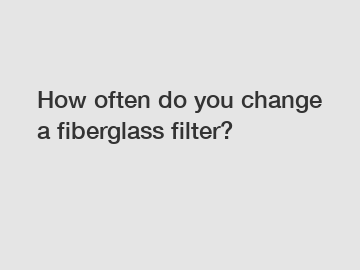How often do you change a fiberglass filter?
Fiberglass filters are commonly used in heating, ventilation, and air conditioning (HVAC) systems to improve indoor air quality by capturing dust, dirt, and other particles. Over time, these filters can become clogged and less effective at trapping airborne contaminants. Therefore, it is important to regularly change fiberglass filters to ensure optimal performance of your HVAC system and improve air quality in your home or office.
Understanding Fiberglass Filters and Their Lifespan.
Fiberglass filters are made of layered fiberglass fibers that create a dense webbing to capture particles as air passes through. These filters are typically one inch thick and are designed to be disposable. The lifespan of a fiberglass filter depends on various factors such as the level of pollutants in the air, the frequency of HVAC system use, and the size of the filter. As a general rule of thumb, fiberglass filters should be changed every 30 to 90 days.

Factors That Impact Filter Lifespan.
The frequency at which you should change your fiberglass filter can vary depending on several factors. Homes with pets may need more frequent filter changes due to the presence of pet dander and hair in the air. Similarly, homes located in dusty environments or near construction sites may require more frequent filter changes to maintain air quality. Additionally, households with individuals who suffer from allergies or respiratory conditions may benefit from changing fiberglass filters more often to ensure clean air.
Signs That It's Time to Change Your Fiberglass Filter.
There are several signs that indicate it's time to change your fiberglass filter. One of the most common signs is reduced airflow from your HVAC system. A clogged filter restricts airflow, causing your system to work harder and potentially leading to increased energy consumption. Another sign is visible debris on the filter itself, indicating that it has reached its capacity for trapping particles. If you notice an increase in dust and dirt around your home or office, it may be time to change your fiberglass filter.
Benefits of Regularly Changing Fiberglass Filters.
Regularly changing fiberglass filters offers several benefits. By maintaining clean filters, you can improve the efficiency of your HVAC system, reduce energy costs, and prolong the lifespan of your equipment. Additionally, clean filters help to prevent the buildup of dust and debris in your ductwork, which can lead to costly repairs down the line. Most importantly, changing fiberglass filters regularly ensures better indoor air quality for you and your family, reducing the risk of respiratory issues and allergies.
Conclusion.
In conclusion, regularly changing fiberglass filters is essential for maintaining the performance of your HVAC system and improving indoor air quality. By understanding the factors that impact filter lifespan, recognizing signs that it's time to change your filter, and reaping the benefits of clean filters, you can ensure a healthier and more comfortable environment in your home or office. Remember to check your fiberglass filter every 30 to 90 days and replace it when necessary to enjoy the full benefits of your HVAC system.
If you have any questions or need assistance with changing your fiberglass filter, feel free to contact us.
For more information, please visit Aluminium Ceramic Filter Plate, Fiber Filter Mesh, fiberglass bag filter.
173
0
0

Comments
All Comments (0)